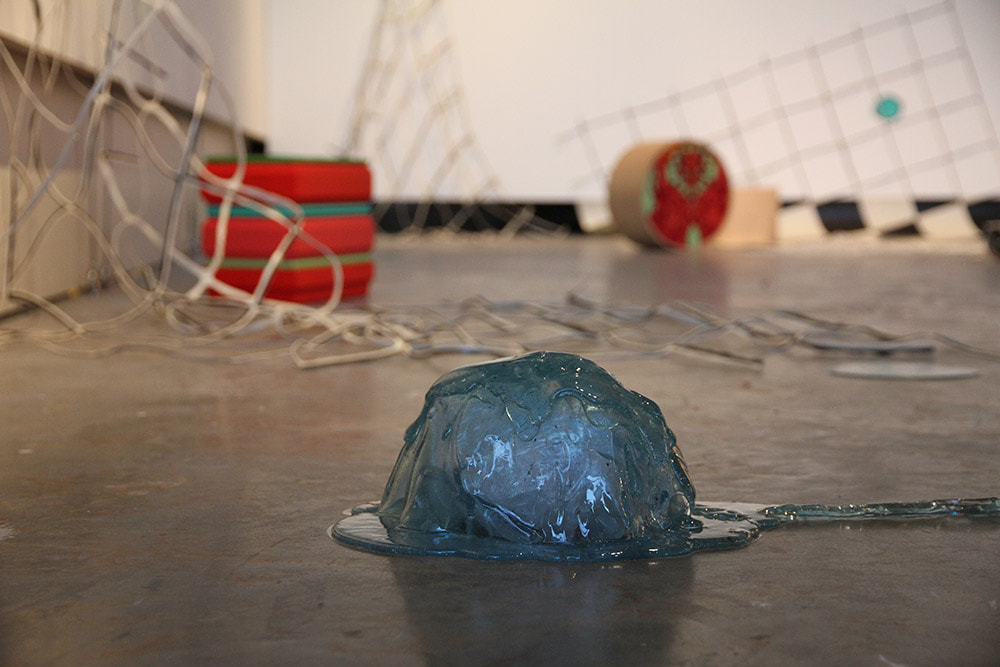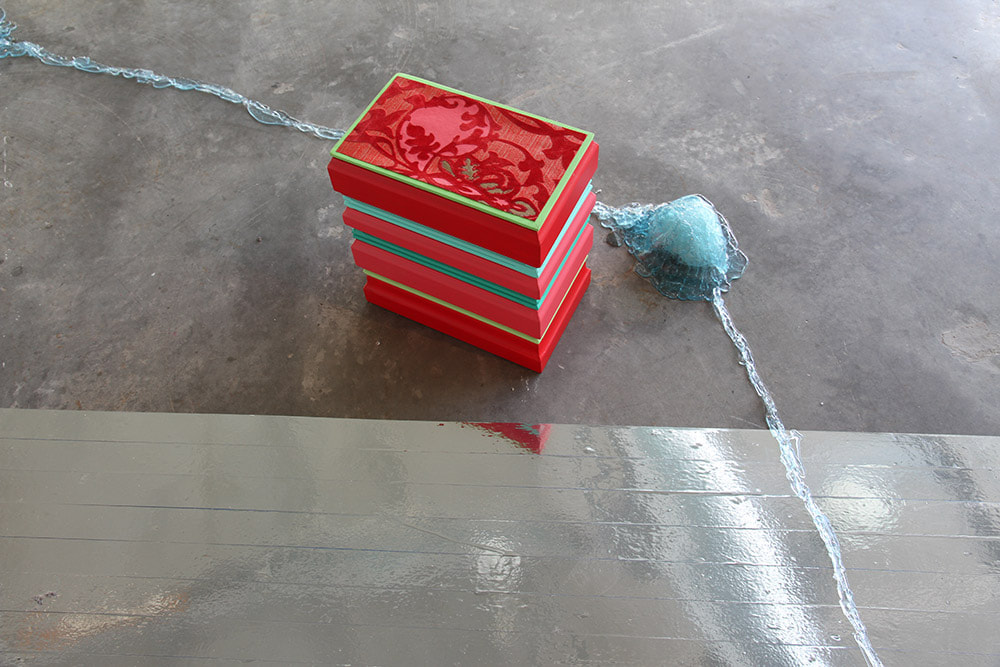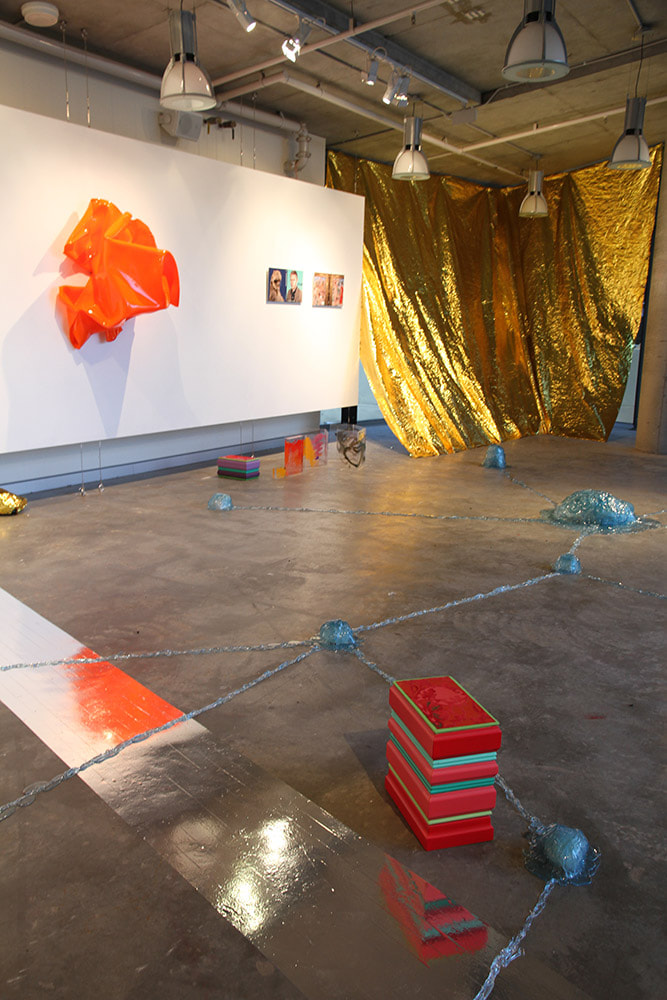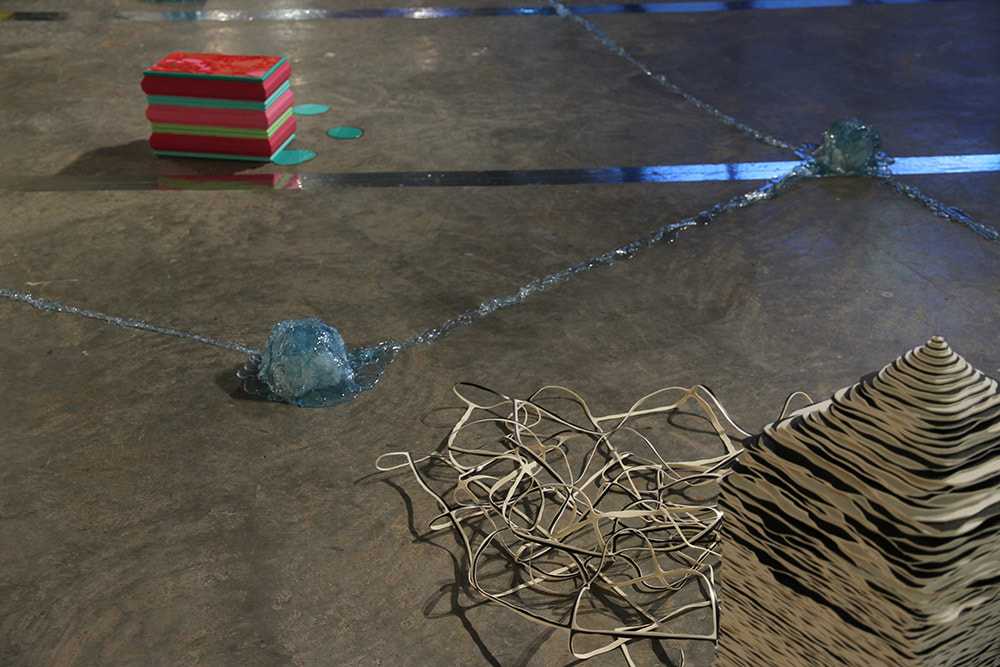Intra-sections 2013 | Verge Gallery
Catalogue Essay
The installation Intra-sections asks the artists involved to put the entire gallery space up for negotiation in order to create a site of interactivity as the artists’ installations spill over and encroach upon each other. Works start to blend creating a reading of the works, which is a conglomeration of everything, all at once – all together. This directly references life’s visual language – the contemporary everyday visual experience. As in the everyday The installation Intra-sections asks the artists involved to put the entire gallery space up for negotiation in order to create a site of interactivity as the artists’ installations spill over and encroach upon each other. Works start to blend creating a reading of the works, which is a conglomeration of everything, all at once – all together. This directly references life’s visual language – the contemporary everyday visual experience. As in the everyday we read and decipher intricate visual systems all the time as things overlap, converge and disjuncture commonly appears: a billboard, a building and a tree. It is a conglomeration of detritus, of ever-pervasive advertising campaigns, dead leaves, bricks and broken bicycles. Where relics co-exist with the latest technology. In this field everything has equal visual presence hierarchies dissolve into a general blur of background noise.
City life and ordinary everyday experiences therefore is a confluence of layered objects, structures and environments from various eras that informs our common understanding of western culture. Everyday life also involves the mundane activities where the emphasis is on personal maintenance and routine and is concerned with the present moment, relationships, activities, emotions and frivolous playful behaviour. Lived experience then informs our understanding and creates a visual referencing system in which we can view art. Intra-sections abstracts this experience, asking the viewer to be a participant, to drift through the space experiencing the ebbs and flows of the installation rather like psychogeography. Intra-Sections is to be experienced in the same way, to be viewed as a total environment, through an open understanding to the currents, vortexes and experiences of the city. Like the everyday, Intra-sections focus is on ordinary events, settings and activities within personal and collective experience, which happens constantly, continuously and simultaneously. This relates to Nicolas Bourriaud’s Relational Aesthetics where theory and practical understanding is taken from the whole of human relations and their social context. The exhibition therefore is interested in everyday visual experience and how it now backgrounds our contemporary understanding of place and things. In installing works in this collective way rather than in an artist’s grouping of works the proximity of contrasting elements creates complex relationships between disparate objects and alters the meanings of things just as in life.
Intra-sections responds to a lecture by British independent curator and artist Paul O’Neill at Artspace Visual Arts Centre in Sydney. O’Neill discussed his approach to exhibition space as background, middle-ground and foreground and to group exhibitions as sites for experimentation and collaboration between artists. Intra-sections puts into practice O’Neill’s ideas through the way space is negotiated as a field in which artists work and openly intersect. The artists’ engagement extends to one another’s work, as each artist must imagine the possibility of their work interceding and connecting with the space and the artists around them.
The artists’ response to contemporary life is first and foremost through a conscious engagement by all the artists with the formal properties of their chosen materials, literal references to a material in its intended everyday use is altered.
In Mark Titmarsh’s use of silly string, an engagement with the formal and social properties of ‘low art’ material is shown. He takes the material out of its usual situation and places it within the sphere of art. He then performs with the silly string in a social context.
Sally Clarke works with chequered linoleum not only for its formal qualities but also for the domesticity inherent to the material. In stacking and gridding the excised linoleum, Clarke alludes to the grid of modernity as well as the cityscape and to one’s grandmother’s kitchen floor. The Chinese-made gold foil Kim Connerton uses to coat interior or exterior surfaces is a direct interaction with architecture. Gold in art history symbolized transcendence, wealth and elevation. She engages in that conversation yet arrives at her chosen material through its accessibility, and reference to re-looking at the whole city not just as ‘paved in gold’ but as a creative space re-configured.
Biljana Jancic’s ‘Spill’ relates to the notion of a light spillage created through a continuation of thinking about mirrored surfaces, self-negation and in absorbing directly from other things and architecture. Jancic references the ephemera capturing a particular configuration of light and drawing attention to shifting light patterns created by the environment.
Sarah Newall’s use of the common materials of paint and plywood for the do-it-yourself-er refers to the formal properties of the materials and their relationship to painting. Her use of these low art materials comments on décor and the individual’s relationship to domestic space. Nuha Saad uses pre-made architectural wooden trim and ornamental wallpaper to make sculptural objects that take the material beyond its original function and intention. In taking on the appearance of minimalist sculptures Saad alters the context of her materials to create sculptural ‘paintings’ that evoke the way domestic interiors act as vessels of personal memory, and how details of colour and décor can catch one’s attention to reveal hidden narratives.
The Twilight Girls blue mucosal slime creeps out across the gallery floor, infecting, coating and ingesting other works. The slime strangely holds form, amorphous yet structured, perhaps a reference to the B-grade masterpiece ‘The Blob’, or even neural pathways.
In Intra-Sections the blurring of the boundaries between the artworks forces an interaction and overlapping. Borders - boundaries - frames disappear as seepage causes cross-pollination, or even infection, to the extent that individual work may morph into another. The exhibition becomes an intense situation of potential collaboration and experimentation materialising into a work in its own right.
Sarah Newall
The installation Intra-sections asks the artists involved to put the entire gallery space up for negotiation in order to create a site of interactivity as the artists’ installations spill over and encroach upon each other. Works start to blend creating a reading of the works, which is a conglomeration of everything, all at once – all together. This directly references life’s visual language – the contemporary everyday visual experience. As in the everyday The installation Intra-sections asks the artists involved to put the entire gallery space up for negotiation in order to create a site of interactivity as the artists’ installations spill over and encroach upon each other. Works start to blend creating a reading of the works, which is a conglomeration of everything, all at once – all together. This directly references life’s visual language – the contemporary everyday visual experience. As in the everyday we read and decipher intricate visual systems all the time as things overlap, converge and disjuncture commonly appears: a billboard, a building and a tree. It is a conglomeration of detritus, of ever-pervasive advertising campaigns, dead leaves, bricks and broken bicycles. Where relics co-exist with the latest technology. In this field everything has equal visual presence hierarchies dissolve into a general blur of background noise.
City life and ordinary everyday experiences therefore is a confluence of layered objects, structures and environments from various eras that informs our common understanding of western culture. Everyday life also involves the mundane activities where the emphasis is on personal maintenance and routine and is concerned with the present moment, relationships, activities, emotions and frivolous playful behaviour. Lived experience then informs our understanding and creates a visual referencing system in which we can view art. Intra-sections abstracts this experience, asking the viewer to be a participant, to drift through the space experiencing the ebbs and flows of the installation rather like psychogeography. Intra-Sections is to be experienced in the same way, to be viewed as a total environment, through an open understanding to the currents, vortexes and experiences of the city. Like the everyday, Intra-sections focus is on ordinary events, settings and activities within personal and collective experience, which happens constantly, continuously and simultaneously. This relates to Nicolas Bourriaud’s Relational Aesthetics where theory and practical understanding is taken from the whole of human relations and their social context. The exhibition therefore is interested in everyday visual experience and how it now backgrounds our contemporary understanding of place and things. In installing works in this collective way rather than in an artist’s grouping of works the proximity of contrasting elements creates complex relationships between disparate objects and alters the meanings of things just as in life.
Intra-sections responds to a lecture by British independent curator and artist Paul O’Neill at Artspace Visual Arts Centre in Sydney. O’Neill discussed his approach to exhibition space as background, middle-ground and foreground and to group exhibitions as sites for experimentation and collaboration between artists. Intra-sections puts into practice O’Neill’s ideas through the way space is negotiated as a field in which artists work and openly intersect. The artists’ engagement extends to one another’s work, as each artist must imagine the possibility of their work interceding and connecting with the space and the artists around them.
The artists’ response to contemporary life is first and foremost through a conscious engagement by all the artists with the formal properties of their chosen materials, literal references to a material in its intended everyday use is altered.
In Mark Titmarsh’s use of silly string, an engagement with the formal and social properties of ‘low art’ material is shown. He takes the material out of its usual situation and places it within the sphere of art. He then performs with the silly string in a social context.
Sally Clarke works with chequered linoleum not only for its formal qualities but also for the domesticity inherent to the material. In stacking and gridding the excised linoleum, Clarke alludes to the grid of modernity as well as the cityscape and to one’s grandmother’s kitchen floor. The Chinese-made gold foil Kim Connerton uses to coat interior or exterior surfaces is a direct interaction with architecture. Gold in art history symbolized transcendence, wealth and elevation. She engages in that conversation yet arrives at her chosen material through its accessibility, and reference to re-looking at the whole city not just as ‘paved in gold’ but as a creative space re-configured.
Biljana Jancic’s ‘Spill’ relates to the notion of a light spillage created through a continuation of thinking about mirrored surfaces, self-negation and in absorbing directly from other things and architecture. Jancic references the ephemera capturing a particular configuration of light and drawing attention to shifting light patterns created by the environment.
Sarah Newall’s use of the common materials of paint and plywood for the do-it-yourself-er refers to the formal properties of the materials and their relationship to painting. Her use of these low art materials comments on décor and the individual’s relationship to domestic space. Nuha Saad uses pre-made architectural wooden trim and ornamental wallpaper to make sculptural objects that take the material beyond its original function and intention. In taking on the appearance of minimalist sculptures Saad alters the context of her materials to create sculptural ‘paintings’ that evoke the way domestic interiors act as vessels of personal memory, and how details of colour and décor can catch one’s attention to reveal hidden narratives.
The Twilight Girls blue mucosal slime creeps out across the gallery floor, infecting, coating and ingesting other works. The slime strangely holds form, amorphous yet structured, perhaps a reference to the B-grade masterpiece ‘The Blob’, or even neural pathways.
In Intra-Sections the blurring of the boundaries between the artworks forces an interaction and overlapping. Borders - boundaries - frames disappear as seepage causes cross-pollination, or even infection, to the extent that individual work may morph into another. The exhibition becomes an intense situation of potential collaboration and experimentation materialising into a work in its own right.
Sarah Newall
Jane Polkinghorne photography
list of works
Sally Clarke,
Power Play, 2010-2013, floor vinyl, variable dimensions
Sarah Newall
faux green Dekor, 2013, acrylic house paint, contact adhesive, plywood, variable dimensions
Nuha Saad
After The Fall, 2013, Acrylic on board, plywood, found wallpaper, dimensions variable
Mark Titmarsh
Spill (14:51), 2013, aluminium tape, painter’s tape
Kim Connerton
gold foil sheets
The Twilight Girls
blue slime, coverseal, bubble wrap
Power Play, 2010-2013, floor vinyl, variable dimensions
Sarah Newall
faux green Dekor, 2013, acrylic house paint, contact adhesive, plywood, variable dimensions
Nuha Saad
After The Fall, 2013, Acrylic on board, plywood, found wallpaper, dimensions variable
Mark Titmarsh
- Chromo-man (performance), 2013
- Chromo-vitruvian-man, 2013, spray string, variable dimensions
- Specific Pointing 3, 2009-2013, slumped perspex, 108x98x60cm
- The Look, 2013
- Ivy Look, 2013, collage on aluminium, 29x53cm
- Renoir, 2013, collage on aluminium, 30.5x52.5cm
- Brushwork, 2013, acrylic dust jacket on acrylic, variable dimensions
- Book of light (red), 2011, acrylic paint on acrylic glass, 31x23x4cm
- Book of light (yellow), 2011, acrylic paint on acrylic glass, 3x12x4cm
- Thomas Pfifer, 2011, acrylic dust jacket on acrylic, variable dimensions
Spill (14:51), 2013, aluminium tape, painter’s tape
Kim Connerton
gold foil sheets
The Twilight Girls
blue slime, coverseal, bubble wrap











